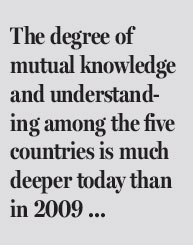BRICS evolving for stronger partnership
The 9th BRICS Summit, which opens in Xiamen, East China's Fujian province, within a week, is being held at a time when the group's circumstances and the international situation both are quite different from those in 2009, when the BRIC grouping officially came into being in Yekaterinburg, Russia.
The creation of the group was almost a "natural" phenomenon in the sense that by 2009 the four economies - Brazil, Russia, India and China - contributed most of the dynamism to the global economy, and thus they were obliged to seek out mechanisms to increase their say in global governance. To achieve the objective, the four countries had to increase their degree of mutual knowledge so as to identify and consolidate common purposes and goals. This is reflected in the systematic increase in the number of articles in the Summit Declarations following the first one. The cost of such an approach is a less easily identifiable common target, as the number of objectives has increased quite significantly.

Furthermore, the performance of the five economies in recent years pales in significance compared with their achievements in the late 2000s, except perhaps India's. China is growing at about half the pace it used to, and the other three BRICS member states have been experiencing very low GDP growth for the past few years. This has reinforced the skepticism among those observers who have always seen the group as a collective of countries with diverse interests and purposes.















